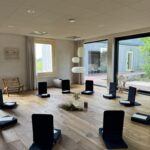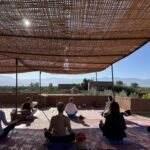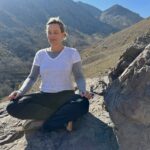This is part two of a series, covering the ten principles of yoga philosophy, also known as the yamas and niyamas. From my perspective as a life coach and teacher, I invite you to discover this ancient wisdom with me. I invite you to explore how you can integrate it all into your daily life. Creating more balance, both on and off the mat to manifest a happier, healthier, richer, and more fulfilling life.
Ahimsa, the Quality of the Strong
Ahimsa is a Sanskrit word that means ‘non-violence’ and it is the foundation of all yogic philosophy. Defined as not having any desire to harm anyone or anything, either physically or psychologically.
It’s one of the 10 yamas and niyamas, also referred to as 10 principles of yoga philosophy. These principles are nothing like commandments or rules. You can consider them as mere suggestions that honor the way a wise person lives.
There is no penalty as such for breaking it as we can experience and investigate the effects of our own actions.
There is no need to place any religious connotation to the word ‘ahimsa’.
It is a process of self-control, self-awareness and awareness of everything that is around you. If you harm someone intentionally, even when it is just in thought, you have lost control of your mind and you are in imbalance with yourself.
Violence means moving away from your true nature and practicing ahimsa simply means coming closer to who you really are.
Challenging Times
It is a challenge to practice non-violence, as we seem to be surrounded by violence in our daily lives. And, unfortunately, running off to an ashram, or spiritual center, somewhere in the Indian countryside will not free you from encountering violence. Been there, done that. There, you might encounter deadly scorpions, buzzing bugs, irritating group members or a bossy teacher. And how about stepping on an ant or ‘killing’ vegetable life for supper?
These kinds of examples can encourage you to become aware of the breadth of the type of violence—and non-violence—I’m talking about. As you deepen into this concept, you may find that at a certain point, you even begin asking yourself on a daily basis how you can display the most non-violent behavior in any given situation.
In my book and workshops, I zoom into many different angels of violence and non-violence but today, let’s check out possible violence in yoga asana and in the way we think.
Violence in Your Yoga Class
As a teacher, it’s fairly easy to spot the student who is not practicing ahimsa in a yoga class. Instead of looking peaceful, their bodies and especially their faces usually start to tense up, and their breath becomes jagged and halting. It looks far from ‘peace in action’.
Non-violence on the yoga mat is all about becoming aware of our appropriate edges without pushing ourselves beyond a point that might cause us harm—that might be violent. It’s about getting stronger and more flexible and, whilst pursuing these goals, knowing exactly when you are hurting yourself and when you are staying within your own safe limits.
I strongly encourage people to go to yoga, to Pilates or to work out and to get physical exercise. By doing so, we can train ourselves in becoming more aware whether something is causing us harm or not. And this helps us out in our day-to-day situation. Most often, we don’t have time to sit and evaluate, let alone meditate on it. We make decisions in split seconds as to whether or not we need to take action.
When we train our bodies and minds for ahimsa to become a state of mind, we can incorporate these non-violent thoughts more easily in our daily lives. This way, we automatically become aware of our instinctive reactions and choose the most non-violent action.
A non-violent action is available in nearly any given situation. If we feel that someone insults us, for example, our initial reaction might be to defend ourselves. A trained mind will assess the situation, and if there is no danger, the choice might be to not defend ourselves, but rather to respond with compassion to the one lashing out.
Push Through the Pain
This is also true in a yoga class, when a posture is given that you know is tricky for your knee that has been operated on, for example. Your initial reaction might be to just push through the pain and try to ignore it because you don’t want to give in. A strong and trained mind will be fully aware of the pinching feeling in the knee and hold back a little or even come out of the pose entirely, ignoring entirely what everyone else is doing in class and focusing fully on what causes harm and what is violent to the body. Coming out of a pose because of a sharp pain is never weak; on the contrary, there is zero gain when there is pain in yoga asana.
Ethically speaking, “cause no pain” holds the crux of the yogic teachings. This means to cause no pain for other beings, and especially, to cause no pain for the self.
Does this mean we should do lame practices and mostly lie on our backs and relax? Not at all! You can have a vigorous practice, making your body and mind stronger, as long as you practice with ahimsa and consciousness about what your body can and cannot do at that particular moment.
To people struggling in class, I suggest that there is probably a very good reason for their struggle. They might carry some extra kilos because they haven’t prioritized a healthy diet. Maybe they aren’t as strong as they used to be because all their time went into work, parenting or caregiving.
In the ancient scriptures about yoga, there was no mention whatsoever of when a posture was perfect, nor aligned or advanced; simply knowing this sometimes helps as well. The only thing that was said about postures in the ancient scriptures is that postures should be comfortable, easy and done with a relaxed mind. It is not just about the gymnastic yoga we see today.
Violence through Judgment
Leave judgment to the Judge.
– the Quran.
Being a yoga teacher or a life-long practitioner doesn’t free you from a judging mind. Especially nowadays, where everyone seems to have an opinion on how yoga could or should be done and what it actually is. This blog post is no different.
We may critique and give voice to what we don’t agree upon. The main idea, however, when referring back to non-violence, is on how we communicate that we do not agree with something. Can we wake up from our own disturbance of wanting to be right the whole time? To tell our own stories so desperately? Can we be conscious of our actions and check before we act, to see whether something is harmful or compassionate?
Only then can we understand what Gandhi was trying to say when he said, “Let us be the change that we want to see in this world.” We can protest, we can disagree, but we can do so in a compassionate and non-violent way. Violence in whatever form is not the answer.
Ahimsa is something we are
The truth is that when we are violent, when we lash out at someone, we are not in balance. On the contrary, we have lost our natural calm, harmony and serenity.
Ahimsa is not something we try to do, it is something that we are. When we see the essence of ourselves in others, there is no other way than to be gentle, compassionate and full of love towards all sentient beings.
When non-violence becomes a lifestyle, we feel it in all aspects of our lives.
I’ve had a chance to see this judgment within me since moving to Morocco.
For one thing, standing in line in Morocco is very simple: You do not. When you apply the European queuing rules, you might need to spend the night at some places because it will never be your turn.
Three years ago, I judged Moroccans to be ignorant, disrespectful and unmannered. Now, I realize that this is the way things go here. It has nothing to do with respect.
You just go with the flow and the guys at the local little grocery shops, or hanouts, are masters in multitasking and helping multiple customers at the same time.
Every single day is a learning experience in this country. This simple example has taught me two things:
- The non-queuing is a cultural difference, but neither way is objectively better than the other;
- I immediately judged when I saw the difference in how they handled the situation.
Nowadays, I check in with myself to see whether I have all the possible elements and knowledge to judge a particular situation before I judge it. So far, I never have!
Just two angles to visit on ahimsa, violence and non-violence.
I’m curious to hear how you practice ahimsa in your daily life and how your actions can influence others.
Let me know in the comments or send me an email!
Namaste,
Rachel








Leave a comment